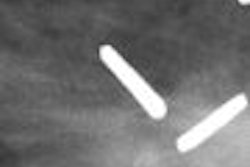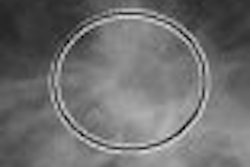Using computed radiography (CR) and full-field digital mammography (FFDM) systems for breast cancer screening cut the radiation dose to tissue in half while maintaining a respectable cancer detection rate, according to German breast cancer specialists, who evaluated the first year of their national digital screening program.
In 2002, the German Parliament implemented a nationwide mammography screening program and three years later, the first routine digital screening unit was installed for dedicated screening, wrote professor Walter Heindel and colleagues at the Universitätsklinikum Münster and the Screening Einheit Münster Sud, both in Münster.
"This is the first analysis of performance indicators after one year of digital screening taking into consideration the average glandular dose," they explained (RöFo, September 2007, Vol. 179:9, pp. 892-895).
One FFDM and two CR systems were used for screening women who either self-referred or responded to a mailed invitation:
- MicroDose Mammography (Sectra, Linköping, Sweden)
- Senographe DMR+ with Direct View CR975 (GE Healthcare, Chalfont St. Giles, U.K.; Carestream Health, Rochester, NY)
- Mammomat 3000 Nova with FCR Profect CS, (Siemens Medical Solutions, Erlangen, Germany; Fujifilm Medical Systems USA, Stamford, CT)
Double reading was done in all cases with suspicious mammograms discussed in consensus. In the first year of the program, 11,413 women were screening on the three units for a participation rate of 57.5%. The average glandular dose (AGD) for system 1 was 0.69 mGy for an average breast thickness of 56 mm. The AGD for system 2 was 1.25 mGy for a breast thickness of 50 mm. Finally, the AGD for system 3 was 1.47 mGy for an average breast thickness of 44 mm.
Out of all the women, 129 were diagnosed with breast cancer for a detection rate of 1.1%. Among these women, 20.9% had ductal carcinoma in situ (DCIS) and the majority of these (60.8%) were tumors smaller than 15 mm. The recall rate was 7%.
"Our digital systems had significantly lower dosage levels than the maximal allowed dosage levels," the authors wrote, pointing out that data from other analog screening programs (Sweden, the Netherlands, U.K.) have posted a mean AGD between 0.8 and 2.5 mGy. In addition, the AGD achieved in this study was below the AGD (1.7 mG7) of analogy mammography screening units tested in a German trial. Finally, the cancer detection rate of 1.1% exceeded the desired level of 0.75%, they stated.
The authors concluded that these first year results were promising, but that methodical and continuous monitoring of the digital screening program was necessary.
In related news, Dr. Per Skaane, Ph.D., and colleagues published follow-up results from the long-term Oslo II study in the September issue of Radiology. This randomized trial in a population-based screening program compared film-screen mammography (FSM) to FFDM with soft-copy reading in close to 24,000 women tested through Oslo's Norwegian Breast Cancer Screening Program (NBCSP).
According to the results, the recall rate was 4.2% for FFDM and 2.5% for FSM, while the cancer detection rate was 0.59% for FFDM and 0.38% for FSM. The researchers found no significant difference between the two systems in terms of positive predictive values.
The median size of screening-detected invasive cancers was 14 mm for FFDM and 13 mm with FSM. FFDM achieved a sensitivity of 77.4% and a specificity of 96.5%. FSM turned in a sensitivity of 61.5% and a specificity of 97.9%.
Skaane's group, hailing from Oslo's Ullevaal University Hospital and the Institute of Population-based Cancer Research, concluded that "FFDM with soft-copy reading is well suited for breast cancer screening programs.... The higher cancer detection rate at (FFDM) might improve the detection of small cancers in breast cancer screening programs, thus making it possible for more women to be treated with breast-conserving surgery" (Radiology, September 2007, Vol. 244:3, pp. 708-717).
By Shalmali Pal
AuntMinnie.com staff writer
August 29, 2007
Related Reading
Sectra gets grant for low-dose mammography, June 14, 2007
RSNA studies delve deeper into DMIST results, December 12, 2006
More DMIST analysis supports FFDM in younger women, dense breasts, November 26, 2006
Do DMIST results underestimate FFDM's impact? October 24, 2005
FFDM fares as well as screen-film for population-based breast screening, December 1, 2002
Copyright © 2007 AuntMinnie.com



















